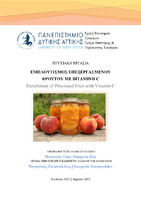| dc.contributor.advisor | Zoumpoulakis, Panagiotis | |
| dc.contributor.author | Τέφα, Παναγιώτα | |
| dc.date.accessioned | 2023-04-03T10:11:03Z | |
| dc.date.available | 2023-04-03T10:11:03Z | |
| dc.date.issued | 2023-03-01 | |
| dc.identifier.uri | https://polynoe.lib.uniwa.gr/xmlui/handle/11400/4151 | |
| dc.identifier.uri | http://dx.doi.org/10.26265/polynoe-3990 | |
| dc.description.abstract | Στη σύγχρονη εποχή όπου ο τομέας των τροφίμων γίνεται όλο και πιο απαιτητικός, είναι λογικό πως υπάρχει αρκετή ζήτηση για την ανάπτυξη νέων τεχνολογιών προς παραγωγή τροφίμων, τα οποία θα έχουν εξίσου καλή ποιότητα και ικανοποιητική σύσταση σε θρεπτικά συστατικά. Ένα από τα συστατικά αυτά είναι και η βιταμίνη C, η οποία είναι από τα πιο «περιζήτητα» θρεπτικά συστατικά στον τομέα του εμπλουτισμού τροφίμων. Η βιταμίνη C είναι όχι μόνο σημαντική βιταμίνη για τον οργανισμό, αλλά επίσης χρησιμοποιείται και ως αντιοξειδωτικό. Είναι δηλαδή αμέσως επόμενο ότι θα έχει πρωταρχικό ρόλο στα εμπλουτισμένα τρόφιμα, μαζί με άλλα μικροθρεπτικά συστατικά (πχ. μέταλλα).
Από τα φυσικά τρόφιμα, πολύ αξιόλογη πηγή βιταμίνης C αποτελεί η ασερόλα. Συγκεκριμένα, η ασερόλα είναι ένα τροπικό φρούτο που έχει περιεκτικότητα σε ασκορβικό οξύ 50 – 100 φορές παραπάνω από ότι θα είχε ένα πορτοκάλι ή λεμόνι. Γνωρίζοντας αυτό, η χρήση της στον τομέα των τροφίμων έχει αρχίσει να γίνεται ακόμα πιο ευρεία.
Σε άλλα πλαίσια, ο εμπλουτισμός σαν τεχνική έχει θεμελιωθεί ήδη στον τομέα των τροφίμων και μπορεί να γίνει με πολλούς τρόπους. Η πηγή εμπλουτισμού μπορεί να είναι είτε φυσική (πχ. φρούτο) είτε τεχνητή (πχ. σκόνη βιταμίνης C). Στην περίπτωση της βιταμίνης C, είναι πιο σύνηθες να χρησιμοποιείται η τεχνητή πηγή, χωρίς βέβαια αυτό να είναι αποκλειστικό.
Στην παρούσα πτυχιακή εργασία εξετάζονται και οι 2 τύποι εμπλουτισμού σε επεξεργασμένο φρούτο. Ο εμπλουτισμός έγινε με α) σιρόπι ασερόλας, β) ασκορβικό οξύ & γ) συνδυασμό αυτών (50 – 50). Οι δοκιμές επιβεβαιώθηκαν με την ογκομετρική μέθοδο μέτρησης του ασκορβικού οξέος στα δείγματα, με πρότυπο δ/μα 2,6-διχλωροφαινυλινδοφαινόλη (DCPIP). Αποδείχθηκε τελικά πως από τους τρεις αυτούς εμπλουτισμούς, ο εμπλουτισμός με συνδυασμό 50 – 50 ήταν ο πιο αποτελεσματικός από όλους. | el |
| dc.format.extent | 52 | el |
| dc.language.iso | el | el |
| dc.publisher | Πανεπιστήμιο Δυτικής Αττικής | el |
| dc.rights | Αναφορά Δημιουργού - Μη Εμπορική Χρήση - Παρόμοια Διανομή 4.0 Διεθνές | * |
| dc.rights | Attribution-NonCommercial-NoDerivatives 4.0 Διεθνές | * |
| dc.rights.uri | http://creativecommons.org/licenses/by-nc-nd/4.0/ | * |
| dc.subject | Vitamin C | el |
| dc.subject | Acerola | el |
| dc.subject | Food enrichment | el |
| dc.subject | Processed fruit | el |
| dc.subject | Vitamin C enrichment | el |
| dc.subject | Ascorbic acid | el |
| dc.subject | Βιταμίνη C | el |
| dc.subject | Ασκορβικό οξύ | el |
| dc.subject | Εμπλουτισμός τροφίμων | el |
| dc.subject | Εμπλουτισμός με βιταμίνη C | el |
| dc.subject | Επεξεργασμένο φρούτο | el |
| dc.subject | Ασερόλα | el |
| dc.subject | Εμπλουτισμός με Ασερόλα | el |
| dc.subject | Enrichment with Acerola | el |
| dc.title | Εμπλουτισμός επεξεργασμένου φρούτου με βιταμίνη C | el |
| dc.title.alternative | Enrichment of processed fruit with vitamin C | el |
| dc.type | Πτυχιακή εργασία | el |
| dc.contributor.committee | Στρατή, Ειρήνη | |
| dc.contributor.committee | Κοντελές, Σπυρίδων | |
| dc.contributor.faculty | Σχολή Επιστημών Τροφίμων | el |
| dc.contributor.department | Τμήμα Επιστήμης και Τεχνολογίας Τροφίμων | el |
| dc.description.abstracttranslated | In the modern era where the food sector is becoming more and more demanding, it is logical that there is enough demand for the development of new technologies for the production of food, which will have equally good quality and a satisfactory composition of nutrients. One of these nutrients is vitamin C, which is one of the most "sought after" nutrients in the field of food fortification. Vitamin C is not only an important vitamin, but it is also used as an antioxidant. It is only expected that it has a primary role in fortified foods, along with other micronutrients (eg. minerals). Regarding natural foods, acerola is a very valuable source of vitamin C. Actually, acerola is a tropical fruit that has 50-100 times more ascorbic acid than an orange or lemon. Knowing this, its use in the food sector has started to become even more widespread.
In other contexts, enrichment as a technique is already established in the food sector and can be done in many ways. The source of enrichment can be either natural (e.g. fruit rich in vitamin C) or artificial (e.g. vitamin C powder). In the case of vitamin C, it is more common to use the artificial source, although this is not exclusive.
In the present thesis, both types of enrichment in processed fruit are examined. The enrichment was done with a) acerola syrup, b) ascorbic acid & c) a combination of these (50 – 50). The tests were confirmed by the volumetric method of measuring ascorbic acid in the samples, with 2,6-dichlorophenylindophenol (DCPIP) standard solution. It turned out that of these three enrichments, the 50-50 combination enrichment was the most effective of all. | el |



